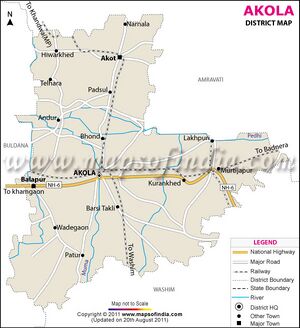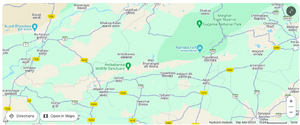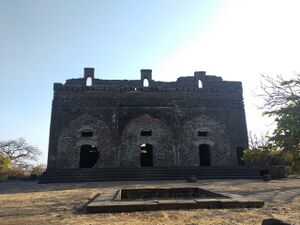Narnala
| Author:Laxman Burdak, IFS (R) |


Narnala (नरनाला) or Narnala Fort, also known as “Shahnur Fort”, is a hill fortress in the Satpura Range of Vidarbha, Akola district of Maharashtra, India.
Variants
- Narnala Fort
- Shahnur Fort
- Narattanga (नरत्तंग)
- Narattangavari (नरत्तंगवारी) mentioned in Tirodi Copper Plate Inscription of the Maharaja Pravarasena II (c.400 - 415) [1]
Origin
The name Narnala was given after the Rao Rana Narnal Singh Solanki, who migrated from Patan in Gujarat.
Location
It is located in the Akot Taluka, Akola District, Berar (also called Amravati Division) at coordinates of 21o 15′ N and 77o 4′ E. The closest city is Akot which is 18 km away. It is at the southern most tip of the Satpura Hills at an elevation of 3161 feet (912 m) above sea level. Currently, this area falls within the Melghat Tiger Reserve.[2]
Narnala Fort

The fort was built in 10 A.D. by Gavli Kings and major fortifications were made by Narnal Singh Swami and some by Rao Rana Narnal Singh Solanki, like the Mahakali Gate. It was then taken over by other Islamic rulers. In the mid 15th century, it was occupied and rebuilt by the Mughals, becoming one of Berar Subah's thirteen sarkar. The fort was captured and fortified by Gond kings during the 16th century. Later, in the late 17th century, it was under Maratha Empire, controlled by Bhonsle of Nagpur Kingdom and their reliable regent and Sardar, earlier the ruler of Narnala, the Solanki Qiledar family of Rao Rana mentioned above.
In 15th Century Mughals have occupied and rebuild the fort and hence it has been called Shahnoor Fort. Narnala was one of the thirteen sarkar of Berar Subah. Narnala consists of three small forts named Zafarabad fort (or Jafarabad) on the east, Narnala in the centre and Teliagarh on the west.[3]
History
The exact date of construction is not known. The first fortifications, according to local legend, were made by Narendrapal or Narnal Singh Swami, a descendant of the Somavanshi Kshatriya Pandavas and at the time Emperor of Hastinapur, a branch from Somvanshi Kshatriya Chalukya ruler of Ayodhya, whose descendant "Rao Rana Narnal Singh", later in early 16th century ruled Narnala for some years. It likely predates 1400 CE as Firishta - the Persian historian- records that 9th Badshah Shahab-ud-din Ahmad Shah I Wali (1422 CE to 1436 CE) during construction of the Gawilgarh fort, made repairs to Narnala fort when he camped at Achalpur (Ellichpur) from 1425 to 1428. This would mean that the Narnala fort was constructed before Bahmani rule.[4]
In 1437, when Nashir Khan the subhedar of Khandesh invaded Berar, the governor of the province (also called Khan-i-Jahan), remained loyal to his master, Ala-ud-din Ahmad Shah II (son of Ahmad Shah I Wali) and retreated to Narnala. He was besieged by disaffected nobles and Nashir Khan, but managed to break through the besieging force with help of Khalaf Hasan Basri who was sent by Ala-ud-din Ahmed Shah II. Nasir Khan was defeated.[5]
In 1487, Narnala along with Gawilgarh came under the control of Fathullah Imad-ul-Mulk, the founder of Imad Shahi dynasty at Ellichpur (or Achalpur). He appointed some regents to rule different parts and forts of the empire, for e.g. Rao Rana Narnal Singh Solanki as Governor of Narnala and sometimes Gawilgad.
In 1572, Burhan Imad Shah (also of the Imad Shahi dynasty) was confined in Narnala by his minister Tufal Khan. This gave Murtaza Nizam Shah of Ahmadnagar a pretext to lay siege to the fortress. He captured both king and minister, subsequently putting them to death. Thus the fort passed into the hands of the Ahmednagar kings. In 1597–98, the fort was captured by Akbar's officers, Saiyid Yusuf Khan Mashhad and Shaikh Abul Fazl, and renamed Shanur. from the officer who held it for the Sultan of Ahmadnagar.[6] During Akbar's rule, Narnala was one of the Sarkars of Berar Subah.
Sardar Beg Mirza and Qader Beg Mirza, hereditary descendants of the Mughal dynasty in the 18th century, stayed near Argaon because Shah Beg Subedar of Berar held the fort.
Narnala was captured by Parsoji Bhosale in 1701 CE and he appointed the Raorana Family descendants the Thakurraos as the governor of Narnala and the surrounding forts and Narnala remained with the Marathas till it was taken over by the British in 1803 CE.
Tirodi Copper Plate Inscription of the Maharaja Pravarasena II (c.400 - 415)
Tirodi Copper Plate Inscription of the Maharaja Pravarasena II (c.400 - 415)[7] ...These plates were found at the manganese mine of Tirodi, 8 miles south-east of Katangi, in the District of Balaghat in Madhya Pradesh. (p.48) ...The plates were issued from Narattangavari (नरत्तंगवारी) by the Vakataka Maharaja Pravarasena II. (p.48)
Narattangavari (नरत्तंगवारी) was probably a tirtha. This is probably a joint name like Nagapura-Nandivardhana, and means Vari near Narattanga. (As there are now and were probably in ancient Vidarbha several villages named Vari or Vārkhed, Narattanga seems to have been fixed to the place-name to define the position of the place intended.) In that case it can be identified with Vari, also called Bhairavagadh (भैरवगढ़), now a deserted village on the river Bān (बाण) or Wān (वाण) in the extreme north-west of the Akot tahsil in the Akola District (At this place there are ruins of a fort called Bhairavgadh, with an image of Kala-Bhairava. The place may have attained importance in the time of Pravarasena II's ancestor Rudrasena I, -who was a fervent devotee of Kala-Bhairava). It is only 18 miles to the west of the old fort of Narnala (नरनाला), which probably represents ancient Narattanga, and is still regarded as a holy place. (p.49)
External links
References
- ↑ Corpus Inscriptionum Indicarum Vol.5 (inscriptions Of The Vakatakas), Edited by Vasudev Vishnu Mirashi, 1963, pp.48-52
- ↑ https://akola.gov.in/tourist-place/narnalafort/
- ↑ https://akola.gov.in/tourist-place/narnalafort/
- ↑ "Imperial Gazetteer2 of India, Volume 18, page 379 - Imperial Gazetteer of India - Digital South Asia Library". Dsal.uchicago.edu.
- ↑ Haig, Sir Wolseley (1907). Historic landmarks of the Deccan - Sir Thomas Wolseley Haig - Internet Archive. Printed at the Pioneer Press. p. 156.
- ↑ Maharashtra Tourism
- ↑ Corpus Inscriptionum Indicarum Vol.5 (inscriptions Of The Vakatakas), Edited by Vasudev Vishnu Mirashi, 1963, pp.48-52

